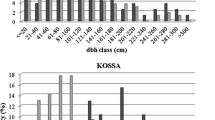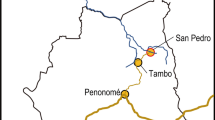Abstract
The effect of arabica coffee management intensity on composition, structure, and regeneration of moist evergreen Afromontane forests was studied in three traditional coffee-management systems of southwest Ethiopia: semiplantation coffee, semiforest coffee, and forest coffee. Vegetation and environmental data were collected in 84 plots from forests varying in intensity of coffee management. After controlling for environmental variation (altitude, aspect, slope, soil nutrient availability, and soil depth), differences in woody species composition, forest structure, and regeneration potential among management systems were compared using one way analysis of variance. The study showed that intensification of forest coffee cultivation to maximize coffee production negatively affects diversity and structure of Ethiopian moist evergreen Afromontane forests. Intensification of coffee productivity starts with the conversion of forest coffee to semiforest coffee, which has significant negative effects on tree seedling abundance. Further intensification leads to the conversion of semiforest to semiplantation coffee, causing significant diversity losses and the collapse of forest structure (decrease of stem density, basal area, crown closure, crown cover, and dominant tree height). Our study underlines the need for shade certification schemes to include variables other than canopy cover and that the loss of species diversity in intensively managed coffee systems may jeopardize the sustainability of coffee production itself through the decrease of ecosystem resilience and disruption of ecosystem services related to coffee yield, such as pollination and pest control.




Similar content being viewed by others
References
Aerts R (2008) Afrocarpus falcatus (Thunb.) C.N.Page. In: Louppe D, Oteng-Amoako AA, Brink M (eds) Record from Protabase. PROTA (Plant Resources of Tropical Africa/Ressources Végétales de l’Afrique tropicale), Wageningen, Netherlands. Available at: http://database.prota.org/search.htm. Accessed: July 23, 2012
Aerts R (2011) Olea capensis L. In: Lemmens RHMJ, Louppe, D, Oteng-Amoako AA (eds) Record from Protabase. PROTA (Plant Resources of Tropical Africa/Ressources Végétales de l’Afrique tropicale), Wageningen, Netherlands. Available at: http://database.prota.org/search.htm. Accessed: July 23, 2012
Aerts R, Honnay O (2011) Forest restoration, biodiversity and ecosystem functioning. BMC Ecol. doi:10.1186/1472-6785-11-29
Aerts R, Nyssen J, Haile M (2009) On the difference between “exclosures” and “enclosures” in ecology and the environment. J Arid Environ 73:762–763
Aerts R, Hundera K, Berecha G, Gijbels P, Baeten M, Van Mechelen M et al (2011) Semi-forest coffee cultivation and the conservation of Ethiopian Afromontane rainforest fragments. Forest Ecol Manage 261:1034–1041
Aerts R, Berecha G, Gijbels P, Hundera K, Van Glabeke S, Vandepitte K, et al. (2012) Genetic variation and risks of introgression in the wild Coffea arabica gene pool in southwestern Ethiopian Montane rainforests. Evol Appl. doi:10.1111/j.1752-4571.2012.00285.x
Ahrends A, Burgess ND, Milledge SAH, Bulling MT, Fisher B, Smart JCR et al (2010) Predictable waves of sequential forest degradation and biodiversity loss spreading from an African city. Proc Natl Acad Sci U S A 107:14556–14561
Allen CD, Macalady AK, Chenchouni H, Bachelet D, McDowell N, Vennetier M et al (2010) A global overview of drought and heat-induced tree mortality reveals emerging climate change risks for forests. Forest Ecol Manage 259:660–684
Anthony F, Combes MC, Astorga C, Bertrand B, Graziosi G, Lashermes P (2002) The origin of cultivated Coffea arabica L. varieties revealed by AFLP and SSR markers. Theor Appl Genet 104:894–900
Bisseleua D, Hervé B, Stefan V (2008) Plant biodiversity and vegetation structure in traditional cocoa forest gardens in southern Cameroon under different management. Biodivers Conserv 17:1821–1835
DeFries RS, Rudel T, Uriarte M, Hansen M (2010) Deforestation driven by urban population growth and agricultural trade in the twenty-first century. Nat Geosci 3:178–181
Eriksson CP, Holmgren P (1996) Estimating stone and boulder content in forest soils—evaluating the potential of surface penetration methods. Catena 28:121–134
Ethiopian Mapping Authority (1988) National atlas of Ethiopia. EMA, Addis Ababa
Friis I (1992) Forests and forest trees of Northeast tropical Africa. Kew Bulletin Additional Series No 15. Her Majesty’s Stationery Office, London, UK
Gardner TA, Barlow J, Chazdon RL, Ewers R, Harvey CA, Peres CA et al (2009) Prospects for tropical forest biodiversity in a human-modified world. Ecol Lett 12:61–582
Gebre-Egziabher T (1978) Some vegetative parameters of coffee, Coffea arabica L., proportional to yield. Ethiopian J Sci 1:51–57
Gole TW (2003) Vegetation of the Yayu Forest in SW Ethiopia: Impacts of human use and implications for in situ conservation of wild Coffea arabica L. populations. Ecology and Development Series No. 10. Centre for Development Research, University of Bonn, Bonn, Germany
Gole TW, Borsch T, Denich M, Teketay D (2008) Floristic composition and environmental factors characterizing coffee forests in southwest Ethiopia. Forest Ecol Manage 255:2138–2150
Hansen MC, Stehman SV, Potapov PV (2010) Quantification of global gross forest cover loss. Proc Natl Acad Sci U S A 107:8650–8655
Hedberg I, Edwards S, Nemomissa S (eds) (2003) Flora of Ethiopia and Eritrea. Volume 4, part 1. Apiaceae to Dipsacaceae. The National Herbarium, Addis Ababa University, Addis Ababa, Ethiopia, and The Department of Systematic Botany, Uppsala University, Uppsala, Sweden
Hernández-Martínez G, Manson RH, Contreras Hernández A (2009) Quantitative classification of coffee agroecosystems spanning a range of production intensities in central Veracruz, Mexico. Agric Ecosyst Environ 134:89–98
Hill MO (1973) Diversity and evenness. Ecology 54:427–432
Hobbs RJ, Arico S, Aronson J, Baron JS, Bridgewater P, Cramer VA et al (2006) Novel ecosystems: theoretical and management aspects of the new ecological world order. Global Ecol Biogeogr 15:1–7
Hundera K, Aerts R, De Beenhouwer M, Van Overtveld K, Helsen K, Muys B, and others. (2012, in press) Both forest fragmentation and coffee cultivation negatively affect epiphytic orchid diversity in Ethiopian moist evergreen Afromontane forests. Biol Conserv. doi:10.1016/j.biocon.2012.10.029
Labouisse JP, Bellachew B, Kotecha S, Bertrand B (2008) Current status of coffee (Coffea arabica L.) genetic resources in Ethiopia: implications for conservation. Gen Resour Crop Evol 55:1079–1093
Lemmens RHMJ (2007) Pouteria adolfi-friederici (Engl.) A.Meeuse. In: Louppe D, Oteng-Amoako AA, Brink M (eds) Record from Protabase. PROTA (Plant Resources of Tropical Africa/Ressources Végétales de l’Afrique tropicale), Wageningen, Netherlands. Available at: http://database.prota.org/search.htm. Accessed: July 23, 2012
McCune B, Keon D (2002) Equations for potential annual direct incident radiation and heat load. J Veg Sci 13:603–606
Millard E (2011) Incorporating agroforestry approaches into commodity value chains. Environ Manage 48:365–377
Perfecto I, Vandermeer J, Mas A, Soto-Pinto L (2005) Biodiversity, yield, and shade coffee certification. Ecol Econ 54:435–446
Philpott SM, Bichier P, Rice R, Greenberg R (2007) Field-testing ecological and economic benefits of coffee certification programs. Conserv Biol 21:975–985
Philpott SM, Arendt WJ, Armbrecht I, Bichier P, Diestch TV, Gordon C et al (2008) Biodiversity loss in Latin American coffee landscapes: review of the evidence on ants, birds, and trees. Conserv Biol 22:1093–1105
Poveda K, Martínez E, Kersch-Becker MF, Bonilla MA, Tscharntke T (2012) Landscape simplification and altitude affect biodiversity, herbivory and Andean potato yield. J Appl Ecol 49:513–522
Priess JA, Mimler M, Klein AM, Schwarze S, Tscharntke T, Steffan-Dewenter I (2007) Linking deforestation scenarios to pollination services and economic returns in coffee agroforestry systems. Ecol Appl 17:407–417
Puetz S, Groeneveld J, Alves LF, Metzger JP, Huth A (2011) Fragmentation drives tropical forest fragments to early successional states: a modelling study for Brazilian Atlantic forests. Ecol Model 222:1986–1997
Ramírez-Marcial N, González-Espinosa M, Williams-Linera G (2001) Anthropogenic disturbance and tree diversity in montane rain forests in Chiapas, Mexico. Forest Ecol Manage 154:311–326
Schmitt CB, Senbeta F, Denich M, Preisinger H, Boehmer HJ (2009) Wild coffee management and plant diversity in the montane rainforest of southwestern Ethiopia. Afr J Ecol 48:78–86
Senbeta F, Denich M (2006) Effects of wild coffee management on species diversity in the Afromontane rainforests of Ethiopia. Forest Ecol Manage 232:68–74
Soto-Pinto L, Perfecto I, Caballero-Nieto J (2002) Shade over coffee: its effects on berry borer, leaf rust and spontaneous herbs in Chiapas, Mexico. Agroforest Syst 55:37–45
Soto-Pinto L, Villalvazo-López V, Jiménez-Ferrer G, Ramírez-Marcial N, Montoya G, Sinclair F (2007) The role of local knowledge in determining shade composition of multistrata coffee systems in Chiapas, Mexico. Biodivers Conserv 16:419–436
Takahashi R, Todo Y (2012) Impact of community-based forest management on forest protection: evidence from an aid-funded project in Ethiopia. Environ Manage 50:396–404
Tilman D, May RM, Lehman CL, Nowak MA (1994) Habitat destruction and the extinction debt. Nature 371:65–66
Trauernicht C, Ticktin T (2005) The effects of non-timber forest product cultivation on the plant community structure and composition of a humid tropical forest in southern Mexico. Forest Ecol Manage 219:269–278
Van Reeuwijk LP (2002) Procedures for soil analysis. International Soil Reference and Information Centre, Wageningen
Vellend M, Verheyen K, Jacquemyn H, Kolb A, Van Calster H, Peterken G et al (2006) Extinction debt of forest plants persists for more than a century following habitat fragmentation. Ecology 87:542–548
Vergara CH, Badano EI (2009) Pollinator diversity increases fruit production in Mexican coffee plantations: the importance of rustic management systems. Agric Ecosyst Environ 129:117–123
Zytynska SE, Fay MF, Penney D, Preziosi RF (2011) Genetic variation in a tropical tree species influences the associated epiphytic plant and invertebrate communities in a complex forest ecosystem. Philos Trans R Soc Lond B Biol Sci 366:1329–1336
Acknowledgments
This research was supported by the IUC-JU program of the Flemish Interuniversity Council (VLIR) at Jimma University, and travel grants by IRO to A. F., M. V. M. and P. G., and R. A. held a postdoctoral fellowship of the Research Foundation–Flanders (FWO). The useful comments of the anonymous referees are gratefully acknowledged.
Author information
Authors and Affiliations
Corresponding author
Additional information
Kitessa Hundera and Raf Aerts contributed equally in this work.
Electronic supplementary material
Below is the link to the electronic supplementary material.
267_2012_9976_MOESM1_ESM.tif
Fig. S1. Effects of forest management in FC, SFC, and SPC systems in southwest Ethiopia on regeneration of late-successional tree species after accounting for environmental variability: a S. guineense. b A. falcatus. c O. welwitschii. d P. Africana. e I. mitis. f P. adolfi-friederici. Error bars denote SE. Letters show significant differences between groups (ANOVA LSD test, α = 0.05).(TIFF 45 kb)
Rights and permissions
About this article
Cite this article
Hundera, K., Aerts, R., Fontaine, A. et al. Effects of Coffee Management Intensity on Composition, Structure, and Regeneration Status of Ethiopian Moist Evergreen Afromontane Forests. Environmental Management 51, 801–809 (2013). https://doi.org/10.1007/s00267-012-9976-5
Received:
Accepted:
Published:
Issue Date:
DOI: https://doi.org/10.1007/s00267-012-9976-5




